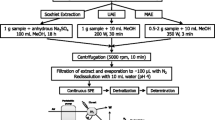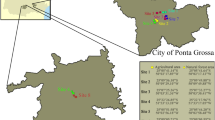Abstract
An analytical methodology based on ultrasound-assisted extraction (UAE) followed by liquid chromatography coupled to tandem mass spectrometry (LC-MS/MS) has been developed for the identification and quantification of 9 authorized herbicides in soil (dimethenamid-P, imazamox, S-metolachlor, nicosulfuron, pendimethalin, prosulfuron, bentazone, terbuthylazine, and mesotrione). Preliminary experiments dealing with solvent extraction, the extraction technique, and herbicide response comparison in soil, with and without organic amendments, were carried out with the purpose of obtaining high sample throughput and sensitivity. UAE and the solvent mixture water:methanol demonstrated higher efficiency and they were selected as sample treatment and extraction solvent, respectively. Critical parameters affecting UAE were optimized by experimental design. In the present research, the extraction technique used in the official EPA microwave-assisted extraction (MAE) methodology (United States Environmental Protection Agency) and UAE optimized methodology were compared. The results indicated that the developed method showed better efficacy since microwave extraction gave very poor responses for nicosulfuron and prosulfuron. The temperature extraction was also optimized; room temperature was the most suitable to work with. Under the optimized conditions, the proposed UAE-LC-MS/MS method was assessed in terms of linearity (R2 ≥ 0.9912), accuracy (recoveries around 100%), and precision (relative standard deviation, RSD < 13%). The absence of significant matrix effects allowed quantification in real samples by external calibration with standards prepared in water:methanol. Method sustainability was also evaluated using the metric tool AGREEPrep. Finally, the analysis of real contaminated samples revealed the presence of 7 out of the 9 studied herbicides with S-metolachlor at high concentrations in all samples.
Graphical abstract







Similar content being viewed by others
References
Baird C, Cann M. Chapter 13: Pesticides. Part IV: Toxic organic compounds. In: Environmental chemistry. 5th ed. W. H. Freeman; 2012. p. 575–622.
Jurado A, Fernandes M, Videira R, Peixoto F, Vicente J. Herbicides: the face and the reverse of the coin. An in vitro approach to the toxicity of herbicides in non-target organisms. In: Herbicides and environment. InTech; 2011:3–44. https://doi.org/10.5772/12976.
Cabrera Mesa A, Spokas KA. 5 Impacts of biochar (black carbon) additions on the sorption and efficacy of herbicides. Herbicides and Environment. InTech. 2011:315–340. https://doi.org/10.5772/13620.
Gámiz B, Hall K, Spokas KA, Cox L. Understanding activation effects on low-temperature biochar for optimization of herbicide sorption. Agronomy. 2019;9(10):588. https://doi.org/10.3390/agronomy9100588.
Haskis P, Mantzos N, Hela D, Patakioutas G, Konstantinou I. Effect of biochar on the mobility and photodegradation of metribuzin and metabolites in soil-biochar thin-layer chromatography plates. Int J Environ Anal Chem. 2019;99(4):310–27. https://doi.org/10.1080/03067319.2019.1597863.
Serelis K, Mantzos N, Meintani D, Konstantinou I. The effect of biochar, hydrochar particles and dissolved organic matter on the photodegradation of metribuzin herbicide in aquatic media. J Environ Chem Eng. 2021;9(1): 105027. https://doi.org/10.1016/j.jece.2021.105027.
Europa. Regulation (EC) No 1107/2009 of the European Parliament and of the Council of 21 October 2009 concerning the placing of plant protection products on the market and repealing Council Directives 79/117/EEC. Official Journal of the European Union, 1107/2009 Oct 21, 2022 p. 1–50.
European Chemicals Agency (ECHA). https://echa.europa.eu/es/home. Accessed 22 Jun 2023.
Europe. Regulation (EC) No 396/2005 of the European Parliament and of the Council of 23 February 2005 on maximum residue levels of pesticides in or on food and feed of plant and animal origin and amending Council Directive 91/414/EEC. Official Journal of the European Union, 396/2005 2005 p. 1–16.
Tadeo JL, Sánchez-Brunete C, Albero B, García-Valcárcel AI. Application of ultrasound-assisted extraction to the determination of contaminants in food and soil samples. J Chromatogr A. 2010;1217(16):2415–40. https://doi.org/10.1016/j.chroma.2009.11.066.
Yan R, Ju F, Wang H, Sun C, Zhang H, Shao M, et al. Determination of sulfonylurea herbicides in soil by ionic liquid-based ultrasonic-assisted extraction high-performance liquid chromatography. Anal Methods. 2014;6(24):9561–6. https://doi.org/10.1039/C4AY01876A.
Tolcha T, Gemechu T, Al-Hamimi S, Megersa N, Turner C. Multivariate optimization of a combined static and dynamic supercritical fluid extraction method for trace analysis of pesticides pollutants in organic honey. J Sep Sci. 2021;44(8):1716–26. https://doi.org/10.1002/jssc.202100047.
Shah J, Rasul · M, Behisht J·, Farhat-Un- A·, Shehzad N, Shah J, et al. Quantification of triazine herbicides in soil by microwave-assisted extraction and high-performance liquid chromatography. Environ Monit Assess. 2011;178:111–9. https://doi.org/10.1007/s10661-010-1676-0.
Yadeta GL. Analysis of multiclass pesticide residues in vegetables using microwave assisted extraction followed by high performance liquid chromatography with ultraviolet detection. Int J Sci Res Eng Trends. 2020;6(3):2395–566.
Albero B, Sánchez-Brunete C, Tadeo JL. Determination of organophosphorus pesticides in fruit juices by matrix solid-phase dispersion and gas chromatography. J Agric Food Chem. 2003;51:6915–21. https://doi.org/10.1021/jf030414m.
Rodríguez-González N, González-Castro MJ, Beceiro-González E, Muniategui-Lorenzo S. Development of a matrix solid phase dispersion methodology for the determination of triazine herbicides in mussels. Food Chem. 2015;15(173):391–6. https://doi.org/10.1016/j.foodchem.2014.09.153.
Wu Q, Li Z, Wu C, Wang C, Wang Z. Application of ultrasound-assisted emulsification microextraction for the determination of triazine herbicides in soil samples by high performance liquid chromatography. Microchim Acta. 2010;170(1–2):59–65. https://doi.org/10.1007/s00604-010-0385-2.
da Costa Marinho MI, Costa AIG, Vieira NM, Paiva MCG, de Freitas FCL, da Silva AA. Validation and application of a QuEChERS based method for estimation of half-life of imidazolinone herbicides in soils by LC-ESI-MS/MS. Ecotoxicol Environ Saf. 2019;15(167):212–7. https://doi.org/10.1016/j.ecoenv.2018.09.075.
Martins GL, Friggi CA, Prestes OD, Vicari MC, Friggi DA, Adaime MB, et al. Simultaneous LC-MS/MS determination of imidazolinone herbicides together with other multiclass pesticide residues in soil. Clean (Weinh). 2014;42(10):1441–9. https://doi.org/10.1002/clen.201300140.
United States Environmental Protection Agency (EPA). SW-846 Test Method 3546: Microwave Extraction. 2007 Feb. https://www.epa.gov/sites/default/files/2015-12/documents/3546.pdf of subordinate document. Accessed 22 Jun 2023.
Pawliszyn J. Comprehensive sampling and sample preparation. Vol. 1. 1st ed. Oxford: Elservier; 2012.
Wojnowski W, Tobiszewski M, Pena-Pereira F, Psillakis E. AGREEPrep – analytical greenness metric for sample preparation. TrAC Trends Anal Chem. 2022;1(149): 116553.
Acknowledgements
This research is based on the Sample Preparation Study Group and Network which is backed by the DAC of the EuChemS.
Funding
The present investigation received financial support from the projects ED431 2020/06 and IN607B 2022/15 (Consolidated Research Groups Program, Xunta de Galicia). Authors are affiliated with the National Network for Sustainability in Sample Preparation, RED2022-134079-T (Ministry of Science, Innovation and Universities, Spain), H.G.L. acknowledges the collaboration grant (Ministry of Education and Vocational Training, Spain). A.C.L. acknowledges the grant for the initiation of USC Master’s research (Santander Research Grants) and the predoctoral contract ED481A/IN606A, Xunta de Galicia.
Author information
Authors and Affiliations
Contributions
Ana Castiñeira-Landeira: investigation, statistical analysis, writing. Lua Vazquez: investigation, statistical analysis. Helena Gonzalez-Leirado: investigation, statistical analysis. Thierry Dagnac: resources, investigation, review, funding. Maria Llompart: project manager, conceptualization, investigation, methodology, statistical analysis, review, funding.
Corresponding author
Ethics declarations
Competing interests
The authors declare no competing interests.
Additional information
Publisher's Note
Springer Nature remains neutral with regard to jurisdictional claims in published maps and institutional affiliations.
Supplementary Information
Below is the link to the electronic supplementary material.
Rights and permissions
Springer Nature or its licensor (e.g. a society or other partner) holds exclusive rights to this article under a publishing agreement with the author(s) or other rightsholder(s); author self-archiving of the accepted manuscript version of this article is solely governed by the terms of such publishing agreement and applicable law.
About this article
Cite this article
Castiñeira-Landeira, A., Vazquez, L., Gonzalez-Leirado, H. et al. Ultrasound-assisted extraction followed by liquid chromatography coupled to tandem mass spectrometry for the simultaneous determination of multiclass herbicides in soil. Anal Bioanal Chem 415, 7197–7209 (2023). https://doi.org/10.1007/s00216-023-04987-y
Received:
Revised:
Accepted:
Published:
Issue Date:
DOI: https://doi.org/10.1007/s00216-023-04987-y




